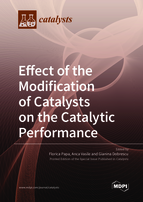Effect of the Modification of Catalysts on the Catalytic Performance
A special issue of Catalysts (ISSN 2073-4344). This special issue belongs to the section "Catalytic Materials".
Deadline for manuscript submissions: closed (31 August 2022) | Viewed by 25713
Special Issue Editors
Interests: catalytic and photocatalytic reaction; mono and bimetallic nanoparticles synthesis by alkaline polyol method; oxidation of C1-C4 aliphatic hydrocarbons on simple and doped oxides; oxidative coupling of methane on rare earth oxides; selective catalytic reduction of nitrates and nitrites in the liquid phase; catalytic oxidation of ammonia nitrogen with ozone in water; modified catalysts and their fractal properties
Special Issues, Collections and Topics in MDPI journals
Interests: catalysis; kinetics of gas-solid interaction; catalytic synthesis; lower olefin (C3–C4) oxidation on multicomponent oxide catalysts; semiconductor properties of oxide catalysts; AC in situ electrical conductivity measurements on catalytic systems; dynamics of the lattice oxygen in oxide catalysts for selective oxidation catalysis; synthesis of well-defined mono/bimetallic nanoparticles supported; photocatalytic degradation of organic compounds in water
Special Issues, Collections and Topics in MDPI journals
Interests: surface science; fractal theory; adsorption mechanism; modelling gases adsorption and desorption from metal-supported catalysts; applying fractal theory to characterize surfaces; modelling adsorption on fractal surfaces; computing fractal dimension from micrographs (TEM, SEM, AFM, STM); growth surfaces and computing the time and spatial scaling exponents using the variable scaling method
Special Issues, Collections and Topics in MDPI journals
Special Issue Information
Dear Colleagues,
A great challenge in the field of catalysis is the synthesis of catalysts with enhanced catalytic activity, selectivity, and durability. The structural and compositional complexity of the catalytic system requires a strong systematic approach to elucidate the nature of the catalyst’s active sites. A catalytic active site is a mono- or polyatomic entity with a specific electronic surface configuration, able to generate a catalytic act (adsorption, dissociation of reactant molecules, and desorption of reaction products).
In-depth knowledge of the composition, structure, and nature of the active sites provides the possibility of tailoring the catalytic properties in order to improve catalytic performance (activity and selectivity). Such properties that can be targeted by synthesis are controlled porosity, sintering, resistance, large specific surface area, optimal acid–base properties, lattice vacancies, metal–support interaction, catalyst design, conductivity, etc.
Therefore, the change in catalyst properties leads to modified kinetic parameters (reaction rate, activation energy) and the reaction mechanism.
Improving catalytic performance by modifying catalysts should play an important role in the current global situation by reducing the negative impact on the environment and supporting the sustainable use of natural resources.
The purpose of this Issue is to present state-of-the-art strategies for modifying catalysts, aiming to provide an important contribution to the development of research in this area from both practical and theoretical perspectives.
We aim to gain a better understanding of catalytic systems, facilitating the establishment of the correlations between composition and physical-chemical properties and performance.
Original research papers and topical reviews are welcome in this Special Issue of Catalysts. Submit your paper and select the Journal “Catalysts” and the Special Issue “Effect of the Modification of Catalysts on the Catalytic Performance” via: MDPI submission system. Please contact the Guest Editor or the journal editor ([email protected]) for any queries. Our papers will be published on a rolling basis and we will be pleased to receive your submission once you have finished it.
Dr. Florica Papa
Dr. Anca Vasile
Dr. Gianina Dobrescu
Guest Editors
Manuscript Submission Information
Manuscripts should be submitted online at www.mdpi.com by registering and logging in to this website. Once you are registered, click here to go to the submission form. Manuscripts can be submitted until the deadline. All submissions that pass pre-check are peer-reviewed. Accepted papers will be published continuously in the journal (as soon as accepted) and will be listed together on the special issue website. Research articles, review articles as well as short communications are invited. For planned papers, a title and short abstract (about 100 words) can be sent to the Editorial Office for announcement on this website.
Submitted manuscripts should not have been published previously, nor be under consideration for publication elsewhere (except conference proceedings papers). All manuscripts are thoroughly refereed through a single-blind peer-review process. A guide for authors and other relevant information for submission of manuscripts is available on the Instructions for Authors page. Catalysts is an international peer-reviewed open access monthly journal published by MDPI.
Please visit the Instructions for Authors page before submitting a manuscript. The Article Processing Charge (APC) for publication in this open access journal is 2700 CHF (Swiss Francs). Submitted papers should be well formatted and use good English. Authors may use MDPI's English editing service prior to publication or during author revisions.
Keywords
- catalytic performance
- catalyst
- synergetic effect
- modification of catalysts
- selectivity
- catalyst synthesis
- reaction mechanism
- catalytic activity








